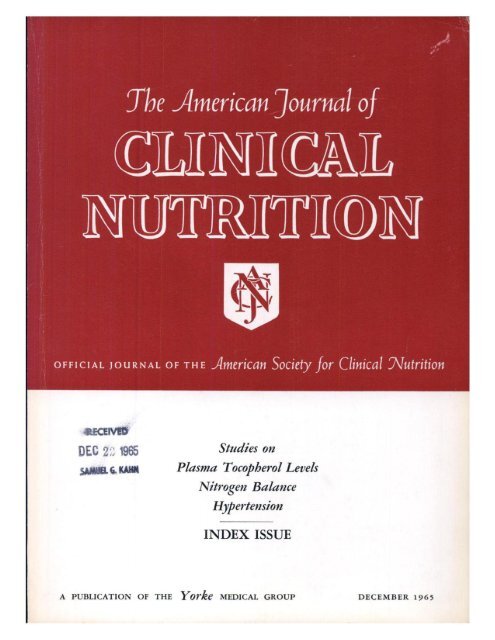Investigating the impact of body weight changes and blood lipids on risk for mild cognitive impairment in Parkinson’s disease: a prospective cohort study
IF 6.9
1区 医学
Q1 NUTRITION & DIETETICS
引用次数: 0
Abstract
Background
Parkinson´s disease (PD) is a neurodegenerative disorder with high risk of cognitive impairment and dementia, where a known risk factor pattern includes low body weight and low blood lipids.
Objectives
This cohort study investigates prospective associations between changes in body mass index (BMI), plasma triglycerides (P-TG) and plasma cholesterol with mild cognitive impairment (MCI) at time of PD diagnosis.
Methods
Patients with PD were identified prospectively in a community-based study of idiopathic Parkinsonism (n = 151) where the patient database was crosslinked to the Northern Sweden Health and Disease Study. The present prospective cohort study (n = 96) considers the timepoint for the healthcare visit the baseline and time for diagnosis as follow-up. At diagnosis of PD, 42 patients (43.8%) were diagnosed with MCI. Associations between prodromal body weight changes and blood lipids with risk of MCI at PD diagnosis were assessed with logistic regression [odd ratio (OR) and 95% confidence intervals (CIs)] adjusted for age and sex.
Results
High P-TG at time of diagnosis were protective for MCI whereas a high age increased risk in patients with PD (OR: 0.31; 95% CI: 0.11, 0.87 and OR: 1.11; 95% CI: 1.02, 1.22, respectively). BMI was not predictive for MCI, neither at diagnosis nor for change over time (adjusted OR 0.99; 95% CI: 0.88, 1.13 and OR 1.12; 95% CI: 0.94, 1.33, respectively). An increase in P-TG was protective for MCI (OR: 0.34; 95% CI: 0.13, 0.88) whereas an interaction between change in BMI and P-TG (OR: 2.21; 95% CI: 1.02, 4.77) increased risk.
Conclusions
High risk of MCI in patients with PD at the time of diagnosis was associated with low levels of P-TG and an interaction between change in BMI and P-TG before diagnosis, suggesting that nutritional factors have complex influence on cognitive function in the prodromal stage of PD.
研究体重变化和血脂对帕金森病轻度认知障碍风险的影响;一项前瞻性队列研究。
背景:帕金森病(PD)是一种具有认知障碍和痴呆高风险的神经退行性疾病,其中已知的危险因素模式包括低体重和低血脂。目的:本队列研究探讨PD诊断时体重指数(BMI)、血浆甘油三酯(P-TG)和血浆胆固醇(P-Chol)变化与轻度认知障碍(MCI)之间的前瞻性关联。方法:在一项基于社区的特发性帕金森病研究(n=151)中前瞻性地确定PD患者,该研究的患者数据库与瑞典北部健康与疾病研究交叉关联。目前的前瞻性队列研究(n=96),认为就诊的时间点为基线,诊断时间为随访。在PD诊断时,42例(43.8%)患者被诊断为轻度认知障碍。通过年龄和性别调整后的logistic回归(OR)和95%可信区间(CIs)评估PD诊断时前驱体重变化和血脂与MCI风险之间的关系。结果:诊断时高P-TG对MCI有保护作用,而高年龄则会增加MCI的风险。PD患者(OR: 0.31;95% CI: 0.11, 0.87, OR: 1.11;95% CI分别为1.02和1.22)。BMI不能预测轻度认知障碍,无论是诊断时还是随时间的变化(调整后OR 0.99;95% CI: 0.88, 1.13, OR 1.12;95% CI分别为0.94和1.33)。P-TG的增加对MCI有保护作用(OR: 0.34;95% CI: 0.13, 0.88),而BMI变化与P-TG之间的相互作用(OR: 2.21;95% CI:1.02, 4.77)增加了风险。结论:PD患者在诊断时发生MCI的高风险与诊断前P-TG水平低以及BMI与P-TG变化的相互作用有关,提示营养因素对PD前驱期认知功能有复杂的影响。
本文章由计算机程序翻译,如有差异,请以英文原文为准。
求助全文
约1分钟内获得全文
求助全文
来源期刊
CiteScore
12.40
自引率
4.20%
发文量
332
审稿时长
38 days
期刊介绍:
American Journal of Clinical Nutrition is recognized as the most highly rated peer-reviewed, primary research journal in nutrition and dietetics.It focuses on publishing the latest research on various topics in nutrition, including but not limited to obesity, vitamins and minerals, nutrition and disease, and energy metabolism.
Purpose:
The purpose of AJCN is to:
Publish original research studies relevant to human and clinical nutrition.
Consider well-controlled clinical studies describing scientific mechanisms, efficacy, and safety of dietary interventions in the context of disease prevention or health benefits.
Encourage public health and epidemiologic studies relevant to human nutrition.
Promote innovative investigations of nutritional questions employing epigenetic, genomic, proteomic, and metabolomic approaches.
Include solicited editorials, book reviews, solicited or unsolicited review articles, invited controversy position papers, and letters to the Editor related to prior AJCN articles.
Peer Review Process:
All submitted material with scientific content undergoes peer review by the Editors or their designees before acceptance for publication.

 求助内容:
求助内容: 应助结果提醒方式:
应助结果提醒方式:


